
 |
 |
 |
Sosai Masutatsu Oyama
| |
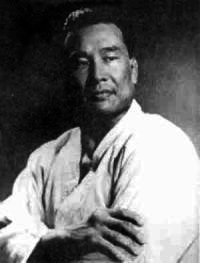 Masutatsu Oyama was born on July 27th, 1923, in the village of Qa-Ryong-Ri Yong-chi-Myo'n Chul Na Do, near the town of Kinje, not far from Gunsan in the southwest of Korea. The village is close to the Yellow Sea which for centuries was occupied by Chinese and Japanese pirates infamous for their pillaging along the coastline. His birthname was Hyung Yee Choi, but when he emigrated to Japan, he was pressured into taking a Japanese name. He chose Oyama, meaning "great mountain", in honor of the family that befriended and took him in while in Japan. Young Hyung Yee was one of the lucky few in the province of Cholapuk Do because he belonged to the Yangban clan. Thus his family was part of the aristocracy. Like his father, Sun Hyang, and his three brothers, Hyung Yee was unusually powerfully built. The family, who was quite wealthy, had a large country estate and his father was also the mayor of Kinje. The road to Yongee Primary School was dirty and narrow, and like the other children, Hyung Yee had to walk the ten kilometres to school. His class contained 60 pupils in a school of 400. Masutatsu Oyama was born on July 27th, 1923, in the village of Qa-Ryong-Ri Yong-chi-Myo'n Chul Na Do, near the town of Kinje, not far from Gunsan in the southwest of Korea. The village is close to the Yellow Sea which for centuries was occupied by Chinese and Japanese pirates infamous for their pillaging along the coastline. His birthname was Hyung Yee Choi, but when he emigrated to Japan, he was pressured into taking a Japanese name. He chose Oyama, meaning "great mountain", in honor of the family that befriended and took him in while in Japan. Young Hyung Yee was one of the lucky few in the province of Cholapuk Do because he belonged to the Yangban clan. Thus his family was part of the aristocracy. Like his father, Sun Hyang, and his three brothers, Hyung Yee was unusually powerfully built. The family, who was quite wealthy, had a large country estate and his father was also the mayor of Kinje. The road to Yongee Primary School was dirty and narrow, and like the other children, Hyung Yee had to walk the ten kilometres to school. His class contained 60 pupils in a school of 400.
|
Discovering Martial Arts
| |
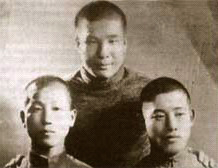 At a relatively young age, he was sent to Manchuria in Southern China to live on his sister's farm. At the age of nine, he started studying the Southern Chinese form of Kempo called Eighteen Techniques (Shaku-Riki system). His teacher was Mr. Yi who at the time was working on his sister's farm. Mas Oyama studied with Mr. Yi for about two years. He attained a level equivalent to Shodan. At a relatively young age, he was sent to Manchuria in Southern China to live on his sister's farm. At the age of nine, he started studying the Southern Chinese form of Kempo called Eighteen Techniques (Shaku-Riki system). His teacher was Mr. Yi who at the time was working on his sister's farm. Mas Oyama studied with Mr. Yi for about two years. He attained a level equivalent to Shodan.
At the age of 13, he returned to Korea to live with his aunt in Seoul and attend junior high school. Hyung Yee was not really interested in his schoolwork. He preferred being outdoors, fishing and swimming with his friends. The one thing that interested him the most was athletics. He participated in football as well as crosscountry running. Even though he failed to show any interest when his brothers tried to teach him boxing, he eventually gravitated towards a martial art named Taiken or Chabee. He was very devoted and rarely missed a training opportunity. Taiken or Chabee is a Korean martial art which is a mixture of Kempo (which itself is similar to Kung Fu) and Ju Jitsu. Chabee came from the Koryo period (912-1392). Before the Koryo period, the Korean peninsula was unionized by the royalty Silla. The fighting techniques used at the end of the Silla era were a mixture of Chinese and Korean martial arts, favoring Chinese hand techniques. It was very different from the old Korean martial arts which contained a lot of head, elbow and foot techniques. During the Koryo era, the Korean peninsula blossomed materially as well as culturally. It was also during this time that the so called Eighteen Techniques developed. Later, a system named the Thirty-Six Techniques was developed and finally both these systems combined to form Chabee.
|
Studying Karate In Japan
| |

This training continued until Mas Oyama was approximately 15 years old. At this point, he moved to Tokyo, Japan to train as an aviator so he could be like Bismarck, his hero of the time. He was enrolled at the Yamanashi Youth Aviation Institute. Survival on his own at that age proved to be more difficult than he thought, especially as a Korean in Japan, so the aviator training fell by the wayside. During this time he started training in boxing and Judo. One day he noticed a student training in Okinawan Karate. He took an interest and went to train at the dojo of Gichin Funakoshi at Takushoku University, where he learned what is known today as Shotokan Karate. The rapid progress of his training was very impressive. By the age of 17, he was already a 2nd Dan. By the age of 20, he was a 4th Dan. At this point he also took a serious interest in Judo and his progress there was no less amazing. By the time he had quit training in Judo, less than four years after he had started, he had achieved the rank of 4th Dan in Judo as well.
|
Mountain Retreat
| |
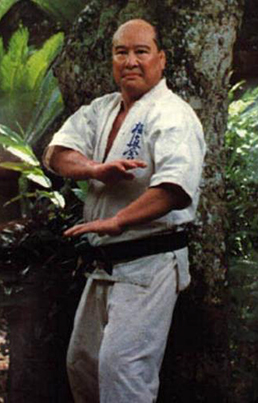 At this time, Mas Oyama entered the Butokukai which was the training academy for the Imperial Japanese military. The Butokukai specialized in guerrilla warfare, espionage and hand to hand combat. Sosai spent two years in this organization which ended with the close of World War II. The defeat of Japan and the subsequent indignity of occupation was very hard to accept for Mas Oyama. He decided to continue his training under the direction of Master So Nei Chu who was also a Korean (from Oyama's own province) living in Japan. He was a Goju expert and student of Chojun Miyagi, the founder of Goju Karate. So Nei Chu, renowned for his physical and spiritual strength, was purported to be the leading expert in Goju Karate in Japan at that time, second only to Miyagi Sensei. It was Master So who encouraged Sosai Oyama to undertake his mountain retreat to strengthen his technical skills and temper his spirit. Mas Oyama was accompanied by one of his own students, but after six months of isolation, the student secretly fled during the night. This left Mas Oyama to continue his vigorous training alone, making it even harder for him because he now longed to return to civilization that much more. So Nei Chu wrote to him and suggested he shave off an eyebrow in order to get rid of the urge to return. Surely he would not want anyone to see him that way! This and other more moving words convinced Oyama to continue, and he resolved to become the most powerful Karate man in Japan. Soon however, his sponsor informed him that he was no longer able to support him, and so after 14 months, he had to end his solitude. A few months later in 1947, after returning to civilization, he tested his abilities in the Karate division of the first Japanese National Martial Arts Championships and won. However he felt empty for not having completed the three years of solitude. He then decided to dedicate his life completely to Karate-do, so he started again - this time on Mount Kiyozumi which was also in Chiba Prefecture. He chose this site for its spiritually uplifting environment. At this time, Mas Oyama entered the Butokukai which was the training academy for the Imperial Japanese military. The Butokukai specialized in guerrilla warfare, espionage and hand to hand combat. Sosai spent two years in this organization which ended with the close of World War II. The defeat of Japan and the subsequent indignity of occupation was very hard to accept for Mas Oyama. He decided to continue his training under the direction of Master So Nei Chu who was also a Korean (from Oyama's own province) living in Japan. He was a Goju expert and student of Chojun Miyagi, the founder of Goju Karate. So Nei Chu, renowned for his physical and spiritual strength, was purported to be the leading expert in Goju Karate in Japan at that time, second only to Miyagi Sensei. It was Master So who encouraged Sosai Oyama to undertake his mountain retreat to strengthen his technical skills and temper his spirit. Mas Oyama was accompanied by one of his own students, but after six months of isolation, the student secretly fled during the night. This left Mas Oyama to continue his vigorous training alone, making it even harder for him because he now longed to return to civilization that much more. So Nei Chu wrote to him and suggested he shave off an eyebrow in order to get rid of the urge to return. Surely he would not want anyone to see him that way! This and other more moving words convinced Oyama to continue, and he resolved to become the most powerful Karate man in Japan. Soon however, his sponsor informed him that he was no longer able to support him, and so after 14 months, he had to end his solitude. A few months later in 1947, after returning to civilization, he tested his abilities in the Karate division of the first Japanese National Martial Arts Championships and won. However he felt empty for not having completed the three years of solitude. He then decided to dedicate his life completely to Karate-do, so he started again - this time on Mount Kiyozumi which was also in Chiba Prefecture. He chose this site for its spiritually uplifting environment.
|
Mountain Training...Again
| |
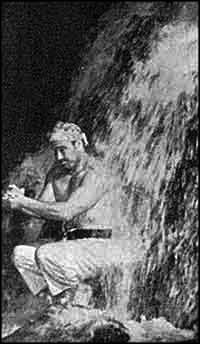 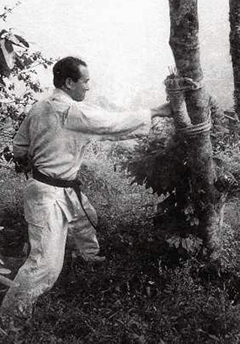
This time his training was fanatical - 12 hours a day every day with no rest days. He stood under cold buffeting waterfalls, broke river stones with his hands, used trees as Makiwara and jumped over rapidly growing flax plants hundreds of times each day. Each day also included a period of study of the ancient classics on the martial arts, Zen and philosophy. After eighteen months, he came down, fully confident of himself and able to take control of his life. Never again would he be so heavily influenced by the society around him (though it is probably safe to say that his circumstances were never again as traumatic).
|
Demonstrating His Karate
| |
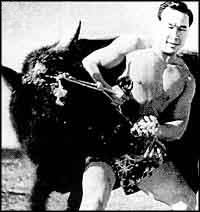 In 1950, Sosai (the founder) Mas Oyama started testing (and demonstrating) his power by fighting bulls. In all, he fought 52 bulls, three of which were killed instantly. The other 49 had their horns taken off with knife-hand blows. That it is not to say that it was all that easy for him. Oyama was fond of remembering that his first attempt simply resulted in an angry bull. In 1957, at the age of 34, he was nearly killed in Mexico when a bull got some of his own back and gored him. Oyama somehow managed to pull the bull off him and broke off his horn. He was bedridden for six months while he recovered from the usually fatal wound. Today of course, animal rights groups would have something to say about these demonstrations, despite the fact that all the animals were already destined for slaughter. In 1950, Sosai (the founder) Mas Oyama started testing (and demonstrating) his power by fighting bulls. In all, he fought 52 bulls, three of which were killed instantly. The other 49 had their horns taken off with knife-hand blows. That it is not to say that it was all that easy for him. Oyama was fond of remembering that his first attempt simply resulted in an angry bull. In 1957, at the age of 34, he was nearly killed in Mexico when a bull got some of his own back and gored him. Oyama somehow managed to pull the bull off him and broke off his horn. He was bedridden for six months while he recovered from the usually fatal wound. Today of course, animal rights groups would have something to say about these demonstrations, despite the fact that all the animals were already destined for slaughter.
In 1952, he traveled the United States for a year, demonstrating his Karate live and on national television. During subsequent years, he took on all challengers, resulting in fights with 270 different people. The vast majority of them were defeated with one punch! A fight never lasted more than three minutes and very rarely lasted more than a few seconds. His fighting principle was simple — if he got through to you, that was it. If he hit you, you broke. If you blocked a rib punch, your arm was broken or dislocated. If you didn't block, your rib was broken. He became known as the Godhand, a living manifestation of the Japanese warrior's maxim "Ichi geki, Hissatsu" or "One strike, certain death". To him, this was the true aim of technique in Karate. The fancy footwork and intricate techniques were secondary (though he was also known for the power of his head kicks). It was during one of his visits to the United States that Sosai Masutatsu Oyama met Jacques Sandulescu, a big Romanian (190 cm tall and 190 kg of muscle) who later on became very well known in Kyokushin. They quickly became friends and remained so for the rest of Sosai Oyama's life. Shihan Jacques still trains and acts as advisor to the I.K.O.(1) to this day.
|
Sosai's First Dojo
| |
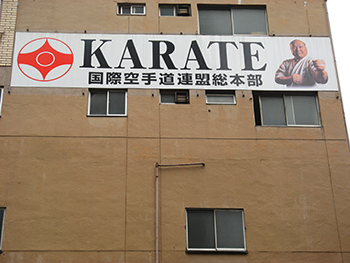 In 1953, Sosai Masutatsu Oyama opened his first "dojo", a grass lot in Mejiro, Tokyo. In 1956, the first real dojo was opened in a former ballet studio behind Rikkyo University, 500 meters from the location of the current Japanese Honbu Dojo (headquarters). By 1957 there were 700 members, despite the high dropout rate due to the extreme nature of the training. Practitioners of other styles came to train here too, in particular for jis-sen kumite (full contact fighting). One of the original instructors, Kenji Kato, has said that they would observe those from other styles and adopt any techniques that "would be good in a real fight". This was how Sosai Masutatsu Oyama's karate evolved. He took techniques from all martial arts and did not restrict himself to karate alone. The students of Sosai Masutatsu Oyama took their kumite seriously because this was a full contact style. They expected to hit and to be hit. With few restrictions, attacking the head was common, usually with the palm heel or towel-wrapped knuckles. Grabs, throws and groin attacks were also common. Kumite rounds would continue until one person loudly conceded defeat. Injuries occurred on a daily basis and the dropout rate was high (over 90%). They had no official dogi and wore whatever they had. In 1953, Sosai Masutatsu Oyama opened his first "dojo", a grass lot in Mejiro, Tokyo. In 1956, the first real dojo was opened in a former ballet studio behind Rikkyo University, 500 meters from the location of the current Japanese Honbu Dojo (headquarters). By 1957 there were 700 members, despite the high dropout rate due to the extreme nature of the training. Practitioners of other styles came to train here too, in particular for jis-sen kumite (full contact fighting). One of the original instructors, Kenji Kato, has said that they would observe those from other styles and adopt any techniques that "would be good in a real fight". This was how Sosai Masutatsu Oyama's karate evolved. He took techniques from all martial arts and did not restrict himself to karate alone. The students of Sosai Masutatsu Oyama took their kumite seriously because this was a full contact style. They expected to hit and to be hit. With few restrictions, attacking the head was common, usually with the palm heel or towel-wrapped knuckles. Grabs, throws and groin attacks were also common. Kumite rounds would continue until one person loudly conceded defeat. Injuries occurred on a daily basis and the dropout rate was high (over 90%). They had no official dogi and wore whatever they had.
|
Bobby Lowe - Sosai's First Uchi Deshi
| |
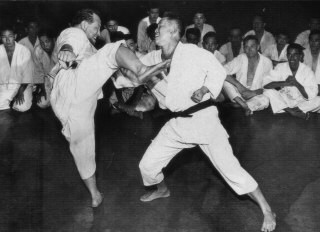 In 1952, Sosai Masutatsu Oyama gave a demonstration in Hawaii. A young Bobby Lowe (seen at left taking a head kick from Mas Oyama) saw him and was stunned by the power Sosai Masutatsu Oyama demonstrated. It was not as though Bobby Lowe was inexperienced in martial arts himself. Though still quite young, his own achievements to date were not much less than those of Sosai Masutatsu Oyama. His father had been a Kung Fu instructor and he had participated in any fighting art he could find. By the age of 23, he was Yondan in Judo, Nidan in Kempo, Shodan in Aikido and a highly regarded welterweight boxer. It was not long before Bobby Lowe became the first Kyokushin uchi deshi or "live-in student" of Sosai Masutatsu Oyama. He trained daily with Sosai Masutatsu Oyama for one and a half years. Eventually, an uchi deshi's time became "1000 days for the beginning". These uchi deshi became known as Wakajishi or the "Young Lions" of Mas Oyama, and only a few of the hundreds of applicants were chosen each year for the privilege of training full-time under the Master. In 1957, Shihan Bobby Lowe returned to Hawaii to open the first School of Oyama outside Japan. In 1952, Sosai Masutatsu Oyama gave a demonstration in Hawaii. A young Bobby Lowe (seen at left taking a head kick from Mas Oyama) saw him and was stunned by the power Sosai Masutatsu Oyama demonstrated. It was not as though Bobby Lowe was inexperienced in martial arts himself. Though still quite young, his own achievements to date were not much less than those of Sosai Masutatsu Oyama. His father had been a Kung Fu instructor and he had participated in any fighting art he could find. By the age of 23, he was Yondan in Judo, Nidan in Kempo, Shodan in Aikido and a highly regarded welterweight boxer. It was not long before Bobby Lowe became the first Kyokushin uchi deshi or "live-in student" of Sosai Masutatsu Oyama. He trained daily with Sosai Masutatsu Oyama for one and a half years. Eventually, an uchi deshi's time became "1000 days for the beginning". These uchi deshi became known as Wakajishi or the "Young Lions" of Mas Oyama, and only a few of the hundreds of applicants were chosen each year for the privilege of training full-time under the Master. In 1957, Shihan Bobby Lowe returned to Hawaii to open the first School of Oyama outside Japan.
|
The Beginning Of Kyokushin
| |
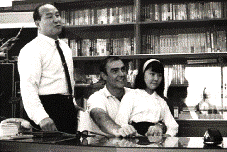 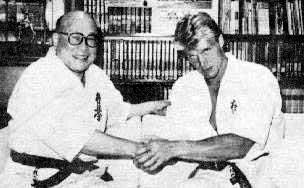
The current World Headquarters were officially opened in June of 1964 and that was where the name Kyokushin, meaning "Ultimate Truth", was adopted. From that point onwards, Kyokushin has continued to spread to more than 120 countries with registered membership exceeding 10 million, making it one of the largest martial arts organizations in the world. Among the better known Kyokushin Yudansha (black belts) are Sean Connery (honorary Shodan) and Dolph Lundgren (Sandan and former Australian heavyweight champion). Also some adepts claim that Nelson Mandela, the President of South Africa, has an honorary 8th Dan which was given to him by the Kyokushin Organization on June 1, 1995. However they fail to mention that Nelson Mandela never accepted this belt. Many believe that the reason for this was because Kyokushin in South Africa supported the Apartheid Regime.
|
Sosai Passes On
| |
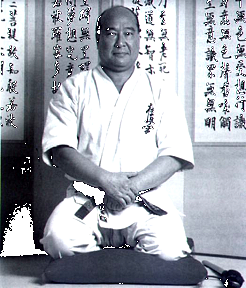 Sadly, Sosai Masutatsu Oyama died of lung cancer (as a non-smoker) at the age of 70 in April of 1994, leaving a confused organization which split into three major groups: the IKO1 under the leadership of Shihan Akiyoshi Matsui, the IKO2 under the leadership of Shihan Yukio Nishida, and the IKO3 under the leadership of Shihan Yoshikazu Matsushima. These three groups have the difficult task of keeping the spirit and the teaching of Kyokushin alive. This has had many political and economic ramifications throughout the Kyokushin world which are still being resolved. In the end, the result may well be a splintering of Kyokushin much like what appears to have happened to Shotokan, with each group claiming to be the one-and-only true heir of Mas Oyama's Kyokushin, spiritually and even financially. However it is reasonably certain that all Kyokushin groups, regardless of their ultimate allegiance, will still maintain the standards set by Sosai Masutatsu Oyama. Maybe a Kyokushin dispersal will be a good thing, since in all good families, some of the children eventually leave home to start their own families. Some of the splinter groups may remain faithful to the Kyokushin principles, like Hanshi Steve Arneil in Great Britain did in 1991. Many others, such as Shigeru Oyama in the United States, have taken it further by developing their own style based on Kyokushin. Sadly, Sosai Masutatsu Oyama died of lung cancer (as a non-smoker) at the age of 70 in April of 1994, leaving a confused organization which split into three major groups: the IKO1 under the leadership of Shihan Akiyoshi Matsui, the IKO2 under the leadership of Shihan Yukio Nishida, and the IKO3 under the leadership of Shihan Yoshikazu Matsushima. These three groups have the difficult task of keeping the spirit and the teaching of Kyokushin alive. This has had many political and economic ramifications throughout the Kyokushin world which are still being resolved. In the end, the result may well be a splintering of Kyokushin much like what appears to have happened to Shotokan, with each group claiming to be the one-and-only true heir of Mas Oyama's Kyokushin, spiritually and even financially. However it is reasonably certain that all Kyokushin groups, regardless of their ultimate allegiance, will still maintain the standards set by Sosai Masutatsu Oyama. Maybe a Kyokushin dispersal will be a good thing, since in all good families, some of the children eventually leave home to start their own families. Some of the splinter groups may remain faithful to the Kyokushin principles, like Hanshi Steve Arneil in Great Britain did in 1991. Many others, such as Shigeru Oyama in the United States, have taken it further by developing their own style based on Kyokushin.
|
|
|
 |
|
|
 |
|
|
|
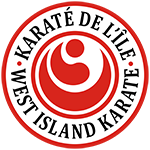 © Copyright 1996. All rights reserved by West Island Karate ®.
© Copyright 1996. All rights reserved by West Island Karate ®.
 |
|
|
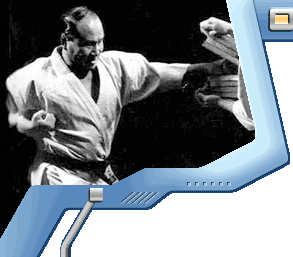





























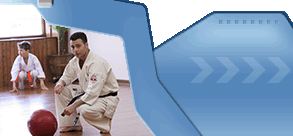


 Masutatsu Oyama was born on July 27th, 1923, in the village of Qa-Ryong-Ri Yong-chi-Myo'n Chul Na Do, near the town of Kinje, not far from Gunsan in the southwest of Korea. The village is close to the Yellow Sea which for centuries was occupied by Chinese and Japanese pirates infamous for their pillaging along the coastline. His birthname was Hyung Yee Choi, but when he emigrated to Japan, he was pressured into taking a Japanese name. He chose Oyama, meaning "great mountain", in honor of the family that befriended and took him in while in Japan. Young Hyung Yee was one of the lucky few in the province of Cholapuk Do because he belonged to the Yangban clan. Thus his family was part of the aristocracy. Like his father, Sun Hyang, and his three brothers, Hyung Yee was unusually powerfully built. The family, who was quite wealthy, had a large country estate and his father was also the mayor of Kinje. The road to Yongee Primary School was dirty and narrow, and like the other children, Hyung Yee had to walk the ten kilometres to school. His class contained 60 pupils in a school of 400.
Masutatsu Oyama was born on July 27th, 1923, in the village of Qa-Ryong-Ri Yong-chi-Myo'n Chul Na Do, near the town of Kinje, not far from Gunsan in the southwest of Korea. The village is close to the Yellow Sea which for centuries was occupied by Chinese and Japanese pirates infamous for their pillaging along the coastline. His birthname was Hyung Yee Choi, but when he emigrated to Japan, he was pressured into taking a Japanese name. He chose Oyama, meaning "great mountain", in honor of the family that befriended and took him in while in Japan. Young Hyung Yee was one of the lucky few in the province of Cholapuk Do because he belonged to the Yangban clan. Thus his family was part of the aristocracy. Like his father, Sun Hyang, and his three brothers, Hyung Yee was unusually powerfully built. The family, who was quite wealthy, had a large country estate and his father was also the mayor of Kinje. The road to Yongee Primary School was dirty and narrow, and like the other children, Hyung Yee had to walk the ten kilometres to school. His class contained 60 pupils in a school of 400. At a relatively young age, he was sent to Manchuria in Southern China to live on his sister's farm. At the age of nine, he started studying the Southern Chinese form of
At a relatively young age, he was sent to Manchuria in Southern China to live on his sister's farm. At the age of nine, he started studying the Southern Chinese form of 
 At this time, Mas Oyama entered the
At this time, Mas Oyama entered the 

 In 1950, Sosai (the founder) Mas Oyama started testing (and demonstrating) his power by
In 1950, Sosai (the founder) Mas Oyama started testing (and demonstrating) his power by  In 1953, Sosai Masutatsu Oyama opened his first "dojo", a grass lot in Mejiro, Tokyo. In 1956, the first real dojo was opened in a former ballet studio behind Rikkyo University, 500 meters from the location of the current Japanese Honbu Dojo (headquarters). By 1957 there were 700 members, despite the high dropout rate due to the extreme nature of the training. Practitioners of other styles came to train here too, in particular for jis-sen kumite (full contact fighting). One of the original instructors, Kenji Kato, has said that they would observe those from other styles and adopt any techniques that "would be good in a real fight". This was how Sosai Masutatsu Oyama's karate evolved. He took techniques from all martial arts and did not restrict himself to karate alone. The students of Sosai Masutatsu Oyama took their kumite seriously because this was a full contact style. They expected to hit and to be hit. With few restrictions, attacking the head was common, usually with the palm heel or towel-wrapped knuckles. Grabs, throws and groin attacks were also common. Kumite rounds would continue until one person loudly conceded defeat. Injuries occurred on a daily basis and the dropout rate was high (over 90%). They had no official dogi and wore whatever they had.
In 1953, Sosai Masutatsu Oyama opened his first "dojo", a grass lot in Mejiro, Tokyo. In 1956, the first real dojo was opened in a former ballet studio behind Rikkyo University, 500 meters from the location of the current Japanese Honbu Dojo (headquarters). By 1957 there were 700 members, despite the high dropout rate due to the extreme nature of the training. Practitioners of other styles came to train here too, in particular for jis-sen kumite (full contact fighting). One of the original instructors, Kenji Kato, has said that they would observe those from other styles and adopt any techniques that "would be good in a real fight". This was how Sosai Masutatsu Oyama's karate evolved. He took techniques from all martial arts and did not restrict himself to karate alone. The students of Sosai Masutatsu Oyama took their kumite seriously because this was a full contact style. They expected to hit and to be hit. With few restrictions, attacking the head was common, usually with the palm heel or towel-wrapped knuckles. Grabs, throws and groin attacks were also common. Kumite rounds would continue until one person loudly conceded defeat. Injuries occurred on a daily basis and the dropout rate was high (over 90%). They had no official dogi and wore whatever they had. In 1952, Sosai Masutatsu Oyama gave a demonstration in Hawaii. A young
In 1952, Sosai Masutatsu Oyama gave a demonstration in Hawaii. A young 

 Sadly, Sosai Masutatsu Oyama died of lung cancer (as a non-smoker) at the age of 70 in April of 1994, leaving a confused organization which split into three major groups: the IKO1 under the leadership of Shihan Akiyoshi Matsui, the IKO2 under the leadership of Shihan Yukio Nishida, and the IKO3 under the leadership of Shihan Yoshikazu Matsushima. These three groups have the difficult task of keeping the spirit and the teaching of Kyokushin alive. This has had many political and economic ramifications throughout the Kyokushin world which are still being resolved. In the end, the result may well be a splintering of Kyokushin much like what appears to have happened to Shotokan, with each group claiming to be the one-and-only true heir of Mas Oyama's Kyokushin, spiritually and even financially. However it is reasonably certain that all Kyokushin groups, regardless of their ultimate allegiance, will still maintain the standards set by Sosai Masutatsu Oyama. Maybe a Kyokushin dispersal will be a good thing, since in all good families, some of the children eventually leave home to start their own families. Some of the splinter groups may remain faithful to the Kyokushin principles, like
Sadly, Sosai Masutatsu Oyama died of lung cancer (as a non-smoker) at the age of 70 in April of 1994, leaving a confused organization which split into three major groups: the IKO1 under the leadership of Shihan Akiyoshi Matsui, the IKO2 under the leadership of Shihan Yukio Nishida, and the IKO3 under the leadership of Shihan Yoshikazu Matsushima. These three groups have the difficult task of keeping the spirit and the teaching of Kyokushin alive. This has had many political and economic ramifications throughout the Kyokushin world which are still being resolved. In the end, the result may well be a splintering of Kyokushin much like what appears to have happened to Shotokan, with each group claiming to be the one-and-only true heir of Mas Oyama's Kyokushin, spiritually and even financially. However it is reasonably certain that all Kyokushin groups, regardless of their ultimate allegiance, will still maintain the standards set by Sosai Masutatsu Oyama. Maybe a Kyokushin dispersal will be a good thing, since in all good families, some of the children eventually leave home to start their own families. Some of the splinter groups may remain faithful to the Kyokushin principles, like